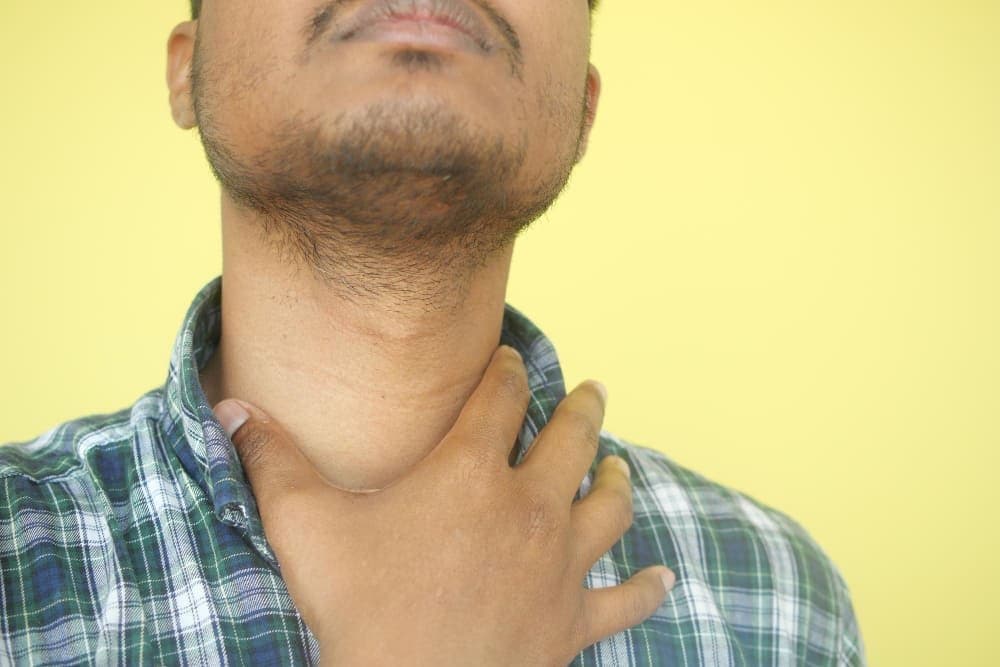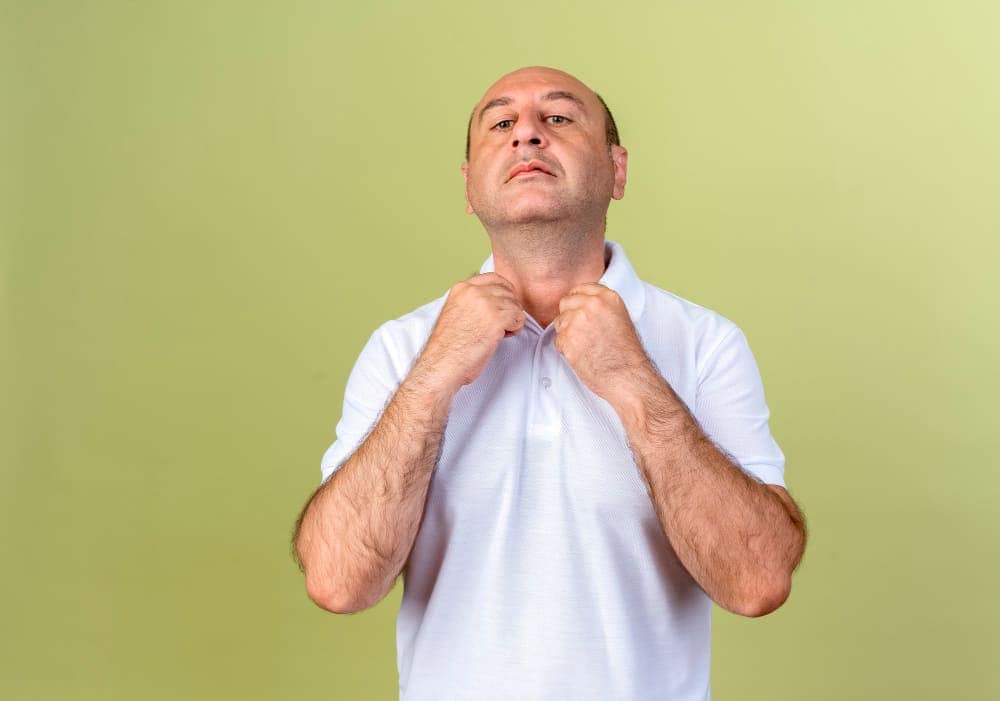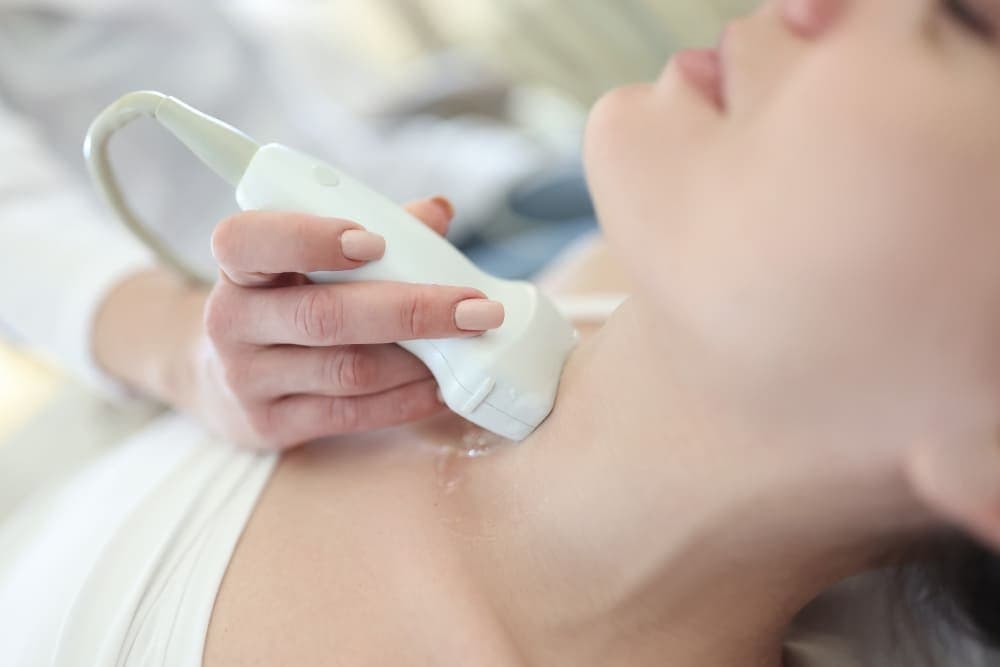Substernal goiter surgery requires specialized expertise when thyroid enlargement extends into the chest. Modern treatment options now include minimally invasive techniques alongside traditional surgical approaches for optimal patient outcomes.

What Are Substernal Goiters?
Substernal goiters develop when your thyroid gland extends below the sternum into your upper chest area. This condition affects roughly 5-20% of all patients who need thyroid surgery.
The thyroid gland normally sits in your neck, positioned in front of the windpipe. However, when goiters form, they can grow downward through the opening between your neck and chest. This happens because the enlarging gland follows the path of least resistance into the chest cavity.
Who gets substernal goiters?
- People over 50 years old
- Women more than men
- Patients with long-standing thyroid nodules
- Those with a family history of thyroid problems
The size of the substernal extension varies greatly. Some goiters extend just slightly into the chest, while others can reach deep toward the heart level. This difference significantly affects which treatment approach works best.
Signs Your Goiter May Be Substernal
Breathing Problems
The most common symptom is difficulty breathing, especially when:
- Lying flat in bed
- During exercise or physical activity
- Climbing stairs or walking uphill
This happens because the enlarged thyroid gland presses against your windpipe, making it harder for air to flow normally.
Swallowing Difficulties
Many patients notice problems swallowing, including:
- Food feels stuck in the throat
- Difficulty with larger pieces of food
- Needing extra water to help food go down
- Avoiding certain textures or foods
Voice Changes
Your voice may change if the goiter affects the nerves controlling your vocal cords:
- Hoarseness that doesn’t go away
- Voice getting tired easily
- Changes in pitch or tone
- Weak or breathy voice quality
Sleep Issues
Large goiters often disrupt sleep patterns:
- Need to sleep propped up on pillows
- Waking up gasping for air
- Snoring that wasn’t present before
- Feeling tired despite a full night’s sleep
Serious Warning Signs 💪
If you experience facial swelling, neck vein bulging, or arm swelling, seek immediate medical attention. These symptoms suggest the goiter may be compressing major blood vessels.
Traditional Surgery Options

Neck Approach Surgery
Transcervical thyroidectomy remains the most common treatment for substernal goiters. This surgical approach uses an incision in your lower neck, similar to regular thyroid surgery.
How it works:
- The surgeon makes a small horizontal incision in the neck
- Carefully identifies important nerves and glands
- Gradually mobilizes and lifts the goiter upward
- Removes the entire thyroid gland through the neck incision
Success rates are excellent – studies show 85-95% of substernal goiters can be removed this way. The key factors for success include:
- Limited extension into the chest
- Soft, flexible goiter tissue
- No previous surgery or scarring
- Experienced surgical team
Recovery timeline:
- Day 1-2: Hospital stay for monitoring
- Week 1: Rest at home, light activities only
- Week 2-3: Gradual return to normal activities
- Month 1: Full recovery expected
Combined Surgical Approaches
When the neck approach isn’t sufficient, surgeons may need to open the chest as well. This combined approach involves both neck and chest surgeons working together.
When chest surgery is needed:
- Goiter extends very deep into the chest
- Dense scar tissue from previous surgery
- Goiter wrapped around major blood vessels
- Failed previous neck surgery attempt
Types of chest surgery:
- Sternotomy: Opening the breastbone
- Thoracotomy: Incision between ribs
- Video-assisted surgery: Small incisions with a camera
Recovery is more complex:
- Days 1-7: Hospital stay with monitoring
- Weeks 1-4: Gradual activity increase
- Months 1-3: Full recovery and strength return
Modern Non-Surgical Treatments
Radiofrequency Ablation: The Heat Treatment 🔥
This innovative technique uses controlled heat to shrink goiter tissue without traditional surgery. It’s becoming increasingly popular for patients who want to avoid major operations.
How radiofrequency works:
- Thin electrodes inserted into the goiter tissue
- Controlled heat destroys abnormal thyroid cells
- The body naturally absorbs the treated tissue
- Goiter shrinks over several months
Perfect candidates include:
- Patients with high surgical risk
- Those preferring non-surgical options
- People with benign thyroid nodules
- Patients with breathing/swallowing symptoms
Treatment experience:
- Duration: 30-60 minutes per session
- Anesthesia: Local numbing with light sedation
- Pain level: Minimal discomfort
- Recovery: Same-day discharge possible
Expected results:
- Volume reduction: 50-80% shrinkage
- Symptom improvement: Often within weeks
- Multiple sessions: May be needed for large goiters
- Long-term success: Excellent patient satisfaction
Microwave Ablation: Advanced Energy Treatment
Microwave ablation works similarly to radiofrequency but uses different energy that can treat larger areas more efficiently.
Advantages of microwave treatment:
- Larger treatment zones per session
- Works well in highly vascular areas
- Fewer treatment sessions are often needed
- Excellent for mixed solid-cystic goiters
The treatment process mirrors radiofrequency:
- Image-guided electrode placement
- Controlled energy delivery
- Real-time monitoring for safety
- Progressive tissue shrinkage over months
Thyroid Artery Embolization for Large Goiters
For very large substernal goiters with extensive blood supply, catheter-based interventions offer another innovative option.
How vascular intervention works:
- Detailed imaging maps the goiter’s blood supply
- Tiny catheters access the feeding blood vessels
- Special materials block blood flow to the goiter
- Reduced blood supply causes tissue shrinkage
Benefits include:
- Outpatient procedure: No hospital stay required
- Local anesthesia only: No general anesthesia risks
- Quick recovery: Back to activities within days
- Can combine: With other treatments if needed
Radiofrequency Ablation for Thyroid Nodules: A Safe, Effective Alternative to Surgery
Choosing Your Best Treatment Option
Medical Evaluation Process
Comprehensive testing includes:
Imaging studies:
- CT scan with contrast for detailed anatomy
- MRI for soft tissue characteristics
- Ultrasound for neck portion evaluation
- Chest X-ray for airway assessment
Function tests:
- Breathing tests to measure airway blockage
- Blood tests for thyroid hormone levels
- Voice assessment if hoarseness is present
- Swallowing study if eating difficulties exist
Risk assessment factors:
- Overall health and age
- Previous neck surgery history
- Current medications and allergies
- Personal treatment preferences
Personalized Treatment Selection 🎯
Young, healthy patients often benefit most from traditional surgery, which provides:
- Complete goiter removal
- Immediate symptom relief
- Long-term cure
- Single treatment session
Older patients or those with health conditions may prefer non-surgical options:
- Lower procedure risks
- Faster recovery times
- No general anesthesia required
- Can repeat if necessary
Very large or complex goiters may require:
- Multidisciplinary team approach
- Combined treatment strategies
- Staged procedures over time
- Specialized center expertise
Recovery and What to Expect
After Traditional Surgery
Hospital stay expectations:
- Neck surgery only: 1-2 days typical
- Combined approach: 3-7 days of monitoring
- Chest tube: May be needed temporarily
- Pain management: Standard medications are effective
Home recovery guidelines:
- Activity: Light activities in the first week
- Diet: Normal eating is usually possible
- Voice: May be hoarse initially
- Wound care: Keep the incision clean and dry
Follow-up schedule:
- Week 1: Wound check and lab tests
- Month 1: Complete healing assessment
- Months 3-6: Hormone level monitoring
- Annually: Long-term surveillance
After Non-Surgical Treatment
Immediate post-procedure:
- Same-day discharge: Usually possible
- Minimal pain: Over-the-counter medications are sufficient
- Normal activities: Resume within 2-3 days
- Work return: Often the next day
Progressive improvement:
- Weeks 1-4: Early symptom relief begins
- Months 1-3: Significant volume reduction
- Months 3-6: Maximum benefit achieved
- Follow-up imaging: Monitors treatment response
Long-Term Success Rates 😊
Traditional surgery outcomes:
- Complete cure: 95-99% success rate
- Symptom relief: Immediate and permanent
- Recurrence: Very rare with total removal
- Patient satisfaction: Consistently high
Non-surgical treatment outcomes:
- Volume reduction: 50-80% average shrinkage
- Symptom improvement: 80-90% of patients
- Repeat treatments: Sometimes beneficial
- Quality of life: Significant improvement
Why Choose Interventional Radiology?
Modern interventional radiology offers cutting-edge treatments that weren’t available just a few years ago. These techniques provide:
Precision treatment:
- Real-time imaging guidance
- Millimeter-accurate targeting
- Protection of critical structures
- Customized energy delivery
Minimal invasiveness:
- No large surgical incisions
- Preserved normal anatomy
- Reduced scarring
- Faster healing
Flexibility:
- Can treat complex locations
- Adaptable to individual anatomy
- Combining with other treatments
- Repeatable if needed
Expert Care Advantages
Dr. Samir Abdel Ghaffar brings specialized expertise in interventional radiology treatments for thyroid conditions. His experience includes:
- Advanced radiofrequency ablation techniques
- Microwave treatment protocols
- Catheter-based interventions for large goiters
- Combination therapy approaches
Patient-centered approach:
- Comprehensive evaluation of all options
- Detailed explanation of risks and benefits
- Personalized treatment recommendations
- Ongoing support throughout recovery
Future of Substernal Goiter Treatment
Emerging Technologies
The field continues advancing with exciting new developments:
Robotic surgery offers enhanced precision for complex cases
AI-guided treatment planning improves outcome prediction
Combination therapies optimize results for challenging situations
New ablation technologies expand treatment possibilities
Research Directions
Current research focuses on:
- Improving treatment durability
- Reducing procedure times
- Enhancing patient comfort
- Developing predictive tools
Your Next Steps 🏥
If you’re experiencing symptoms of substernal goiter, don’t wait for them to worsen. Modern treatment options offer excellent results with approaches suited to your individual needs and preferences.
Whether you’re considering traditional surgery or innovative non-surgical treatments, the key is working with experienced specialists who understand the complexity of substernal goiters and can guide you to the best solution for your specific situation.
Schedule a consultation today to explore your options and take the first step toward breathing easier and living better.



